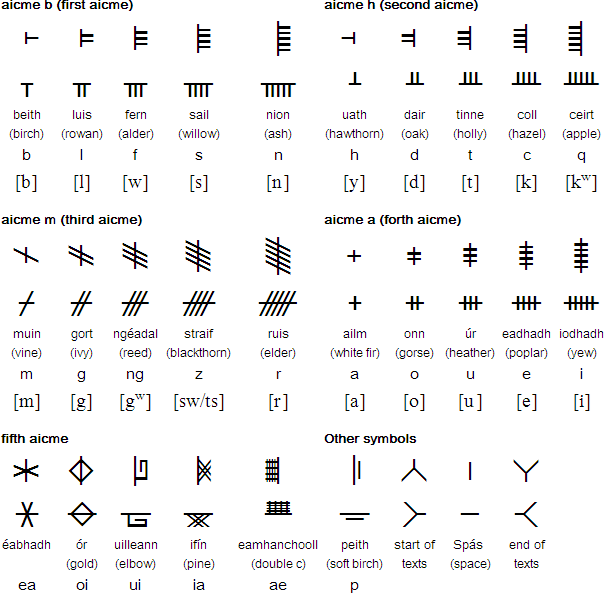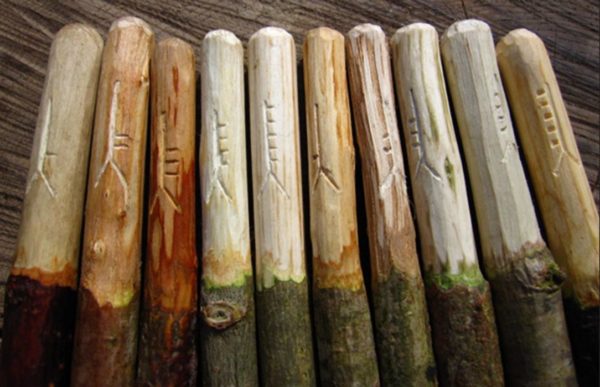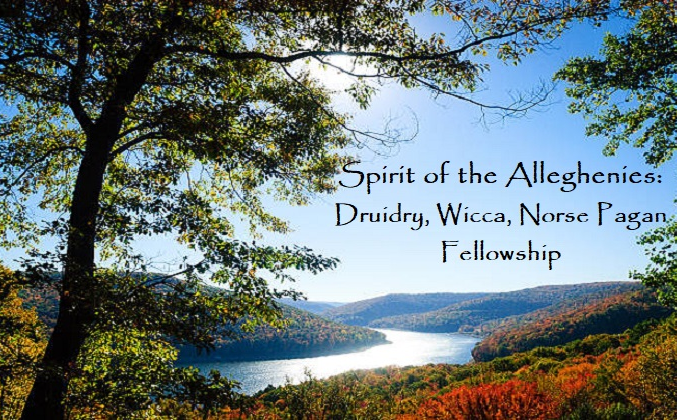Ogham, pronounced “Oh-um,” is a form of writing dating from the 4th century CE (and possibly earlier), which uses dashes or notches carved in a line into stone or wood, the number and position of which determining the letters. Each letter is representative of a native tree and is taken from the first letter of that tree’s name in Irish Gaelic. These are divided into four basic groups or aicme, each having five letters. A fifth aicme, the forfeda or “extra letters,” was later added to express diphthongs (“sounds formed by the combination of two vowels in a single syllable, in which the sound begins as one vowel and moves toward another, as in coin, loud, and side.” – Cited from Google Dictionary) These letters are strung together to form Gaelic words and sentences on either vertical or horizontal lines. Check out the chart below (cited from https://omniglot.com):


Ogham script was carved onto stone monuments (of which more than four hundred survive) and according to written sources also carved into wooden staves or posts, though none of those have survived to the present day. Some three hundred Ogham monuments are found in Ireland, with the remaining scattered across the British Isles. The Ogham script was carved vertically into the edges of the standing stones and was read from bottom to top and from right to left. Many of the monuments served logistical purposes such as marking property boundaries, or identifying a grave site, though contemporary druids use the script for sacred writing and for making magical charms.
It is uncertain whether the Ogham script influenced the Norse runes or vice versa, but the two coexisted as evidenced by the Bressay Stone in the Shetland Islands (Tenth Century), carved with Ogham letters translating to a Norse inscription: “The cross of Necrudad, daughter of An (in memory of her husband) Benises son of Droan.” A stone dating to the early Twelfth Century in County Clare, Ireland, features both Ogham script and Norse runes, indicating the influence of both Irish and Viking culture.

The origins of Ogham are shrouded in the mists of time. Medieval manuscripts heavily influenced by Christian mysticism, such as the Eleventh Century Lebor Gabala Erenn, ascribe the development of Ogham to the period shortly after the destruction of the Tower of Babel, while the Ogam Tract (late Fourteenth Century) attributes the alphabet to the Gaelic god Ogma, a member of the Tuatha Dé Danann who was gifted in language, poetry, and the arts, and who created the Ogham script as a language for the learned druids. The Ogam Tract also claims that sound is the father of Ogham and matter its mother.
Another origin story, and the central theme of Robert Graves in his seminal work The White Goddess holds that the Ogham alphabet, or at least the concept for the alphabet, originated in the Welsh tale, Cad Goddeu or The Battle of the Trees. In this story, a mortal farmer named Amaethon steals a dog, a roebuck, and a lapwing, the three secrets of agricultural, from Arawn, King of the Otherworld. Arawn is furious and unleashes a terrible monster upon Britain. The beast has one hundred heads and a host of lesser monsters beneath each of its tongues. It is accompanied by a serpent bearing a thousand tortured souls, the terrifying armies of the Underworld. Amaethon flees to seek his brother, the High Druid, Gwydion, who sings a powerful song-spell to awaken the forest trees to fight against Arawn’s host. The trees assemble into four battle hosts according to their kind, which corresponds with the four original Ogham aicme. Fighting on humanity’s behalf, the tree army defeats the Underworld host, and the battle is decided when Gwydion correctly identifies Arawn’s aide-de-camp, Bran (possibly Bran the Blessed.) Arawn concedes the victory and allows humanity to keep the secrets of agriculture. Whether or not the Ogham alphabet originated from the Cad Goddeu is debatable, but the fact that it names the same trees as those identified in the Tree Army is undeniable. A later blog post will examine this argument in more depth.

Modern Ogham Staves (www.druidry.org)

Ancient Ogham Standing Stones
